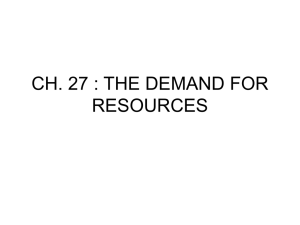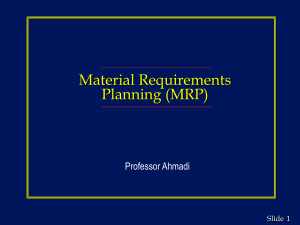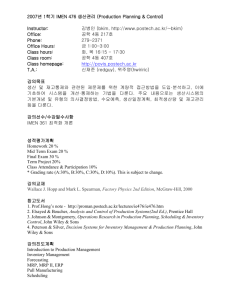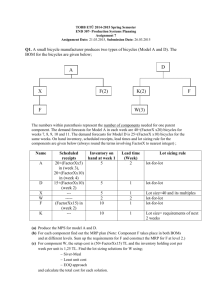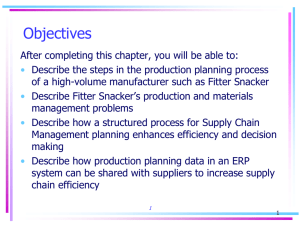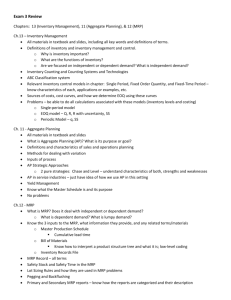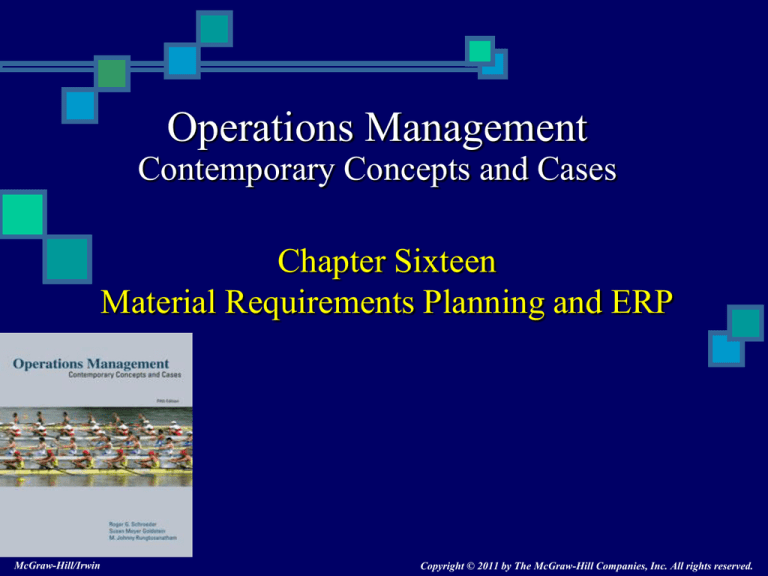
Operations Management
Contemporary Concepts and Cases
Chapter Sixteen
Material Requirements Planning and ERP
McGraw-Hill/Irwin
Copyright © 2011 by The McGraw-Hill Companies, Inc. All rights reserved.
Chapter 16 Outline
Definitions of MRP Systems
MRP versus Order Point Systems
MRP Example
MRP Elements
Operating an MRP System
The Successful MRP System
Enterprise Resource Planning Systems
16-2
Introduction to MRP
Used to manage dependent demand items
– Raw materials and purchased parts
– Work in process (WIP)
Driven by the master schedule (which is driven by
S&OP)
End items ‘exploded’ into all requirements for
components using bill of materials (BOM)
Schedule offset based on lead times
Is a push system used when the master schedule is
constantly changing
16-3
Definitions of MRP Systems
Developed by Joe Orlicky at IBM, 1975
– IBM 370 was the first computer with the capacity to
handle MRP calculations
Types of MRP
– Type I: An inventory control system (MRP)
– Type II: Manufacturing Resource Planning system (MRPII)
– Type III: Enterprise Resource Planning (ERP) system
16-4
Definitions of MRP Systems
Three principal functions of MRP (Orlicky):
Inventory
– Order the right part
– Order in the right quantity
– Order at the right time
Priorities
– Order with the right due date
– Keep the due date valid
Capacity
– A complete load
– An accurate (valid) load
– An adequate time span for visibility of future load
16-5
Closed Loop MRP System (Fig. 16.1)
Firm orders from
Customers
Sister plants
Stock replenishment
S & OP
Master
schedule
Forecast of Demand
Rough-cut
capacity planning
Engineering Design changes
BOM
MRP Parts
Explosion
Inventory Records
Inv. Transactions
Purchase Orders
Shop Orders
Capacity planning
Shop-floor control
Vendors
Raw Materials
Operations
Product
16-6
Comparison of MRP & Order-Point Systems
Attribute
MRP
Order Point
Demand
Dependent
Independent
Order philosophy
Requirements
Replenishment
Forecast
Based on master schedule
Based on past demand
Control concept
Control all items
ABC
Objectives
Meet manufacturing needs
Meet customer needs
Lot sizing
Discrete
EOQ
Demand pattern
Lumpy but predictable
Random
Types of inventory Work in process and raw
materials
Finished goods and spare
parts
16-7
MRP Elements
Inputs
1. Master Schedule
2. Bill of Materials (BOM)
3. Inventory Records
Capacity Planning (feasibility)
Planned Order Releases (outputs)
–
–
Purchasing (buy)
Shop Floor Control (make)
16-8
MRP Inputs
Master schedule
Product structure file (bill of materials, BOM)
–
–
Parts & subassemblies of product
Sequence of operations
Inventory master file
–
–
Item master information
Balances & ordering information
16-9
MRP Example of BOM
Top
Leg
Short Rail
Long Rail
16-10
BOM (Product Structure)
Table (End Item)
1 week
Leg Assembly (1)
1 week
Short Rails (2) Long Rails (2)
1 week
1 week
Top (1)
2 weeks
Legs (4)
1 week
16-11
Indented BOM
Level Code
0
1
2
2
2
1
Component
Table (end-item)
Leg assembly (1)
Short rails (2)
Long rails (2)
Legs (4)
Top(1)
16-12
MATERIALS PLAN
WEEK
Table 16.4
Materials plan for
Levels 0 and 1 in
BOM
*****PART*****
Tables
Tops
Leg
Assembly
1
2
3
4
5
6
GROSS REQUIREMENTS:
0
0
0
200
150
100
SCHEDULED RECEIPTS
0
0
0
0
0
0
PROJECTED ON HAND
50
50
50
50
0
0
NET REQUIREMENTS
0
0
0
150
150
100
PLAN. ORDER RELEASES
0
0
150
150
100
0
GROSS REQUIREMENTS:
0
0
150
150
100
0
SCHEDULED RECEIPTS
0
50
0
0
0
0
PROJECTED ON HAND
50
50
100
0
0
0
NET REQUIREMENTS
0
0
50
150
100
0
PLAN. ORDER RELEASES
50
150
100
0
0
0
GROSS REQUIREMENTS:
0
0
150
150
100
0
SCHEDULED RECEIPTS
0
0
0
0
0
0
100
100
100
0
0
0
NET REQUIREMENTS
0
0
50
150
100
0
PLAN. ORDER RELEASES
0
50
150
100
0
0
PROJECTED ON HAND
16-13
Materials Plan
In Table 16.4, note the following:
Gross requirements in level 0 (Tables) come from the
master schedule.
Gross requirements in level 1 (and below) come from
the planned order releases in the level above.
Planned order releases are offset by the lead times.
Planned order releases are planned! Actual order
releases must take available capacity into account.
Net requirements are the gross requirements minus
the projected on-hand.
16-14
Master Schedule
Quantities derived from S&OP production plan
(product groups) [input]
Drives MRP process with a schedule of finished
products (actual items by week) [output]
Quantities may consist of a combination of
customer orders & demand forecasts
Quantities represent what needs to be produced,
not what can be produced (infinite capacity
planning)
16-15
Bill of Materials (BOM)
Structured list of all parts and materials
Must be 100 percent accurate
Should be one BOM per product per company
Requires an effective engineering change order
(ECO) system
16-16
Inventory Records
Item master segment
– Information that is fairly constant (part number, etc.)
Inventory status segment
– Materials plan for each item
Subsidiary data segment
– Outstanding orders
– Demand history, etc.
Records must be accurate, i.e., counting required
16-17
Counting Inventory (1)
In the past, inventory was counted to learn how
much was on hand.
Now, inventory is counted to confirm the
computer records.
Two basic methods of counting inventory
– Annual count (all at once)
– Cycle counting
16-18
Counting Inventory (2)
Annual Count
– Shut down and have everyone count
– Hire a counting firm
– Problems
No guarantee of accuracy
Lost production or work
Boring!
– Advantage
Everything done at once (as/of date)
16-19
Counting Inventory (3)
Cycle Counting
– Count continuously throughout year
– Use ABC methods to set priorities and
frequency of counting
– Count by calendar or ‘trigger’
– Problems
Not everything is counted at once
May interfere with normal work
– Advantages
More accurate
Less disruptive
16-20
Counting Inventory (4)
The Future? RFIS/RFIT/RFID
–
–
–
–
–
Chip imbedded in items
Transmits when polled
Everything done from base station
“Smart Shelves” know what is on them
Problems
Cost/market penetration
May not read
– Advantages
No explicit counting
Continuous tracking
16-21
Capacity Planning
Purpose is to aid management in checking on the
validity of the master schedule
Two ways it can be done
– Rough-cut capacity (resource) planning
– Shop loading
Alternative is finite capacity scheduling
16-22
Purchasing
Greatly enhanced by use of MRP
Past due orders largely eliminated
Order expediting eliminated
Can provide vendors with reports of planned
future orders
Can use EDI to communicate directly with
vendors
16-23
Shop Floor Control
Purposes
– Release orders to the shop floor
– Manage the orders on their way through the factory
Can use Manufacturing Execution System (MES)
Set job priorities (dispatching rules)
Manage lead times on basis of priority
– Both expedite and deexpedite orders
Requires valid due dates
16-24
Operating an MRP System
Should MRP carry “safety stock”?
How much “safety stock” should be
carried?
Issue of “safety lead time”
Danger of “informal” system driving out
the “formal” system
16-25
Required Elements for a
Successful MRP System
1. Implementation planning
2. Adequate computer support
3. Accurate data
4. Management support
5. User knowledge
16-26
Operating a Successful
MRP System
Accurate inventory records
Stable master production schedule
Realistic master production schedule
Good control of engineering change orders
(impacts BOM)
Good interface with capacity planning (CRP)
Reports that are useful
16-27
Enterprise Resource Planning
(ERP) Systems
Extension and integration of all functions
through a common database
– Forces standard systems throughout the organization
ERP used to coordinate decisions along the
supply chain
Expensive and time-consuming to
implement.
16-28
Enterprise Resource Planning
(ERP) Systems
Major large-scale ERP software
vendors
– SAP (Systems, Applications & Products)
– Oracle
See: www.erpfans.com
16-29
Summary
Definitions of MRP Systems
MRP versus Order Point Systems
MRP Example
MRP Elements
Operating an MRP System
The Successful MRP System
Enterprise Resource Planning Systems
16-30
End of Chapter Sixteen
16-31

